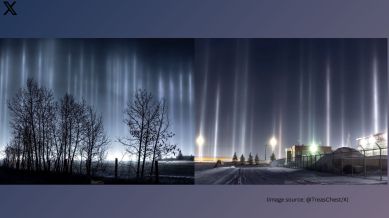Residents capture stunning light pillars in the night sky in Canada’s Alberta; here’s how this phenomenon occurs
This rare phenomenon forms when light refracts through suspended ice crystals.

People in Central Alberta, Canada, recently got to witness light pillars light up the night sky. These impressive vertical beams of light appear to rise from the ground, reaching towards the sky, creating a surreal, mirror-like effect. While they might seem like something out of a high-budget science fiction movie, these light pillars are actually an optical illusion caused by particular winter weather conditions.
People’s posts capture the phenomenon:
monthly limit of free stories.
with an Express account.
They were also spotted in Russia earlier this month.
How are light pillars formed?
This rare phenomenon occurs when light gets refracted through ice crystals, creating stunning columns of light. The light pillars’ colour usually matches the light’s source.
AccuWeather Meteorologist David Samuhel, in a blog on the company’s website, explained that these optical wonders often form near streetlights, but virtually any light source can create them under the right conditions. “They appear as beams of light to the observer. It is usually caused by street lights. However, any source of light can create a light pillar given proper conditions,” Samuhel said in the blog.
For light pillars to appear, conditions need to be cold and calm—windless, in fact. The ice crystals must remain suspended in the air, which only happens when temperatures drop below freezing, typically between minus 10 and 20 degrees Fahrenheit. “In most instances, temperatures are minus 10 to 20 degrees or colder,” Samuhel said.
How are light pillars different from auroras?
Light pillars are different in many ways. Auroras are visible over large areas and occur far up in the atmosphere, while light pillars are localised near the ground. “Auroras are observed across a much wider area, since they occur many miles up in the atmosphere. Light pillars occur close to the ground in the lowest levels of the atmosphere,” Samuhel explained.
Light pillars also do not show up on radar. “If you can predict cold and calm conditions, you can probably forecast when light pillars are able to be seen. But, the forecasting of ice crystal formation is more difficult,” Samuhel said, adding that while the phenomenon is fascinating, predicting its occurrence is far from simple.